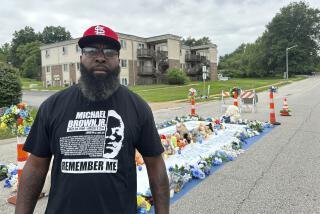Civic Leaders Beginning Drive to Make August Free of Murders
KANSAS CITY, Mo. — In this city, like so many others, violent death among inner-city youth has become so routine that people hardly notice any more. But, since May, City Councilwoman Carol Coe and a handful of civic leaders have laid a plan to engage the machinery of law enforcement, social services and media saturation to prove it doesn’t have to be that way. They have resolved to make August a month without murders.
It’s a tall order. Last year, Kansas City averaged about 10 homicides each month, one every three days. Starting today, residents are being bombarded with the message--by radio, TV, rallies, parades, from the pulpit and in workshops --to think twice before striking someone on impulse.
Although the number of murders in Kansas City is dwarfed by other cities--Los Angeles had 991 homicides last year, for example--the organizers of the campaign think their message might be useful elsewhere.
“Most of the people interviewed by the police after their crimes said, ‘Boy, if I had stepped back and thought about this, I could have avoided this whole incident,’ ” Coe said. From that realization evolved the campaign’s slogan: “Step Back and Think: Violence, Give It Up!” Coe believes it could reduce the murder rate partly, or even completely. “They did it in 1949,” she said. “They can do it in 1991.”
Coe refers to a campaign started in 1949 by the city’s black newspaper, The Call. Alarmed at the rate of black-on-black killings, the paper invited readers to send in suggestions to stop “this community evil.” Hundreds of letters were received. Readers blamed the crime wave on liquor, arguments over women, concealed weapons, failure to cooperate with police, as well as overcrowding and segregation. Each week, The Call updated its murder chronicle. By Feb. 25, the city’s total was 12 homicides; nine were black-on-black.
Then a curious thing happened. The murders stopped. On March 11, the paper noted soberly: “No slayings among Negroes have occurred so far this month.” April 1, 1949, The Call ran this exultant front-page headline: “No Murders in Month of March.”
The woman who wrote the chronicle, Lucile Bluford, is now 80 years old and publisher of The Call. “We were the only ones doing it, we didn’t have a citywide organization like we have today” to promote alternatives to violence, she said. She had forgotten about the 1949 episode until Coe found it in the files.
The recent murder epidemic touched Bluford directly in May, when a 28-year-old reporter for her newspaper was stabbed to death with a kitchen knife. The woman’s husband has been charged. So far this year, 70 homicides have been committed in Kansas City. Of those, 55 have been blacks killed by blacks.
The Centers for Disease Control has determined that homicide is the leading cause of death for all blacks, male and female, between ages 15 and 34. Dr. Mark Mitchell, formerly deputy health director for Kansas City, said: “A lot of homicide occurs because people don’t realize violence leads to homicide, there’s so much violence in their lives.”
With a grant from the CDC, Mitchell created a program to teach young people how to avoid conflict. Youths referred by schools or juvenile authorities get 10 hours of training and role-playing. Mitchell said preliminary results show violent outbursts are reduced by half. That’s the most aggressive prevention tactic in the city. Coe’s group is also going into churches to talk about stress awareness and the effect of drug and alcohol abuse in the black community.
“If we could just keep two or three people from being killed, if one mother calls and says, ‘My daughter needs some domestic violence counseling,’ ” it will be worth the effort, Coe said. “We have got to start talking about murders as if there’s something wrong with them.”
More to Read
Sign up for Essential California
The most important California stories and recommendations in your inbox every morning.
You may occasionally receive promotional content from the Los Angeles Times.










